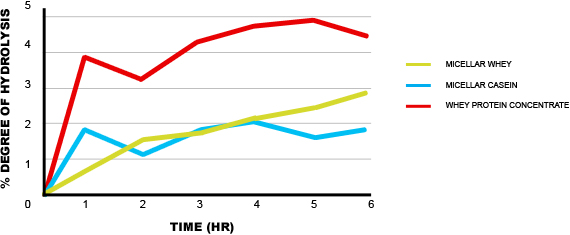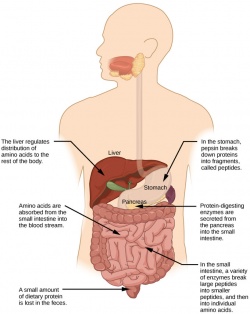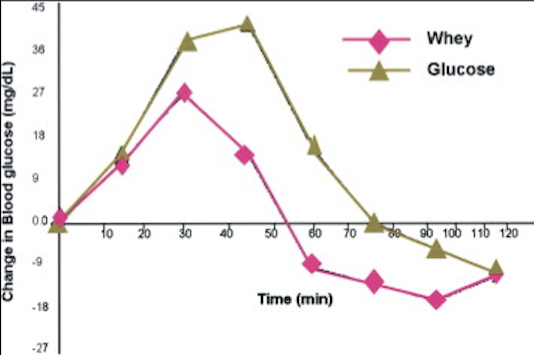Exercise and Protein Supplements
Introduction[edit | edit source]
Containers of protein powders line the shelves of many supplement stores and are typically a highly purchased product. Protein supplements can be used for a variety of reasons such to help build muscle mass, help with exercise recovery, and can even be used as a meal replacement. Due to the wide variety of usages, this supplement will be used by many types of people and found commonly in a physical therapy clinic. As a physical therapist it is crucial to know how protein metabolizes, the different types of protein supplements that are commonly sold, the effects on timing of ingestion of protein supplements, how protein effects different types of exercise, how age and gender influence protein supplementation, and lastly any additional side effects protein supplements may have.
Types of Protein Supplements
[edit | edit source]
Protein supplementation has a wide variety of options. Here is a general list of the most common types of supplementation available:
Whey[edit | edit source]
Whey is a protein that is a by-product in cheese production. Whey accounts for 20% of the protein found in milk. This protein metabolizes fast and is the most popular type of the three. Whey is also high in muscle-building amino acids like leucine, isoleucine, and valine. There are two main types of whey protein sold as well as a blend of the two together. These variations are Whey Isolate and Whey Concentrate. Isolate tends to be higher quality and contains between 90 and 98% protein. Concentrate contains between 70 and 85% protein [1].
Casein[edit | edit source]
Casein is a protein that makes up the remaining 80% of the protein in milk. Casein digests slowly and is a popular choice as a weight gainer. It contains a little more than 90% protein in general and encourages the body to metabolize carbs and fats first. Casein is also a popular choice for muscle building.
Soy[edit | edit source]
Soy protein is a fast digesting protein that is of high quality. It is not as efficient as the milk proteins; therefore, it is not as desirable for those looking to build muscle.
Soy protein supplementation has had a lot of controversy over its effect on muscle through use with resistance training, but also the positives and negatives of some of its potential side effects. The main content of soy protein supplements is the soy bean. In a 2006 study, the effects of whey and soy protein with resistance training young men and women in comparison to a blinded control group. The results showed that soy protein in combination with resistance training produces the same effects as whey protein supplementation. [2]
How Protein Metabolizes and Protein's Effects on the Body[edit | edit source]
Protein metabolism in the body occurs differently from the other macronutrients, as there is no type of storage for proteins. Proteins are composed of Carbon, Hydrogen, and Oxygen, and Nitrogen. Amino acids are the building blocks of proteins, and are connected by peptide bonds Cite error: Invalid <ref> tag; name cannot be a simple integer. Use a descriptive title. Amino acids are the usable form that is necessary for digestion to occur. There are 9 essential amino acids that must be consumed, and 11 non-essential amino acids that can be synthesized in the body. A complete protein contains all 9 essential amino acids, while an incomplete protein lacks one or more essential amino acids. Complete proteins are typically seen in animal products, while incomplete proteins are commonly seen in plant sources.
Protein metabolism begins in the stomach. The enzyme pepsinogen in converted to the active pepsin form when in the presence of the highly acidic hydrochloric acid (HCl). Pepsin begins to break down the peptide bonds to form dipeptides and amino acids necessary for digestion. Enzymes, including Trypsin, Chymotrypsin, and Carboxypeptidase, from the pancreas and small intestine are also secreted when needed to break any remaining peptide bonds that escaped the stomach. The amino acids are then absorbed in the small intestine and released in the blood stream Cite error: Invalid <ref> tag; name cannot be a simple integer. Use a descriptive title.
Proteins are responsible for a number of roles in the body. However, while carbohydrate and fats can be used for energy, proteins do not supply energy directly to the body. Instead proteins are utilized to form blood transporters, enzymes, participate in hormonal regulation, fluid balance, and acid-base balance, and act as a structural component in connective tissue and muscle Cite error: Invalid <ref> tag; name cannot be a simple integer. Use a descriptive title.
Cite error: Invalid <ref> tag; name cannot be a simple integer. Use a descriptive title
Timing of Protein Supplementation[edit | edit source]
"The timing of protein ingestion has been identified as another key factore modulating post-exercise muscle protein anabolism."[4]
Protein ingestion before and/or during exercise:[edit | edit source]
Minimal research exists supporting the positive impact of protein supplementation before or during exercise. The majority of studies completed have been inconclusive; however, one study showed that the ingestion of protein before and/or during exercise "stimulates muscle protein synthesis during exercise. Therefore, protein ingestion before and/or during prolonged exercise training may inhibit muscle protein breakdown, stimulate muscle protein synthesis, and further augment the skeletal muscle adaptive response to exercise training."[5] The same study stated that, "Dietary protein ingestion before and/or during exercise may provide more effective feeding strategy to improve amino acid availability during early post-exercise recovery."[6]
Protein ingestion after exercise:[edit | edit source]
The following research statements summarize the effects of post-exercise protein supplementation on related physiologic processes.
"The intake of protein after resistance training increases plasma amino acids, which results in the activation of signaling molecules leading to increased muscle protein synthesis and muscle hypertrophy."[7]
"Dietary protein ingestion after exercise increases post-exercise muscle protein synthesis rates, stimulates net muscle protein accretion, and facilitates the skeletal muscle adaptive response to prolonged exercise training."[8]
"beneficial effects such as reduced muscle soreness and markers of muscle damage become more evident when supplemental protein is consumed after daily training sessions."[9]
In one study researchers investigated the impact of amino acid (lysine, proline, alanine, and arginine) and/or conjugated linoleic acid (CLA) supplements administered before and after aerobic exercise on body weight, percentage body fat, waist and hip circumference, triglycerides and LDL-cholesterol levels [10]. When compared to the placebo group, the waist and hip circumference and BMI of the experimental group after aerobic exercise was a clinically significant.
Types of Exercise and Protein Supplementation[edit | edit source]
Aerobic Exercise [edit | edit source]
Energy and macronutrient needs, especially carbohydrate and protein, must be met during times of high physical activity to maintain body weight, replenish glycogen stores, and provide adequate protein to build and repair tissue.The American Dietetic Association takes the stand that during extreme bouts of exercise, replenishment of CHO and Pro stores are necessary to rebuild tissues in response to the extra protein while extra CHO will restore the glycogen reserve, and both macronutrients will maintain body weight.[11] Endurance athletes usually take CHO supplements during long bouts of exercise to replenish their glycogen stores in order to continue their workout. Studies have been done to prove that carbohydrate-protein (CHO-Pro) supplementation taken after a bout of exercise improves the performance of an endurance athlete and if ingested during a bout of exercise protein oxidation is increased.[12] Even though further research is needed, it is hypothesized that protein use as an energy source is increased during a glycogen-depleted state. Improved recovery and less muscle damage have been associated with CHO-Pro drinks post--exercise. More research is needed to understand the effects of CHO-Pro post-exercise but some studies have revealed improvements in “glycogen repletion, protein balance, muscle-damage, and subsequent performance”(Saunders). [12] No matter the controversy, CHO-Pro drinks have a lot of potential for endurance athletes during and post-exercise. The balance of protein could be improved, muscle damage could decrease and a positive effect on future performance could occur due to the increase of protein intake in aerobic athletes.
Age and the Effects of Protein Supplementation[edit | edit source]
Gender and the Effects of Protein Supplementation[edit | edit source]
Additional Side Effects[edit | edit source]
In addition to its effects on muscles, the use of protein supplements may also come with a number of other side effects, both chronic and acute. Several studies have shown that increased protein intake through the use of protein supplements can have the effect of lowering both systolic and diastolic blood pressure. Its use may therefore be beneficial in managing the blood pressure of those with hypertension. However, one needs to exercise caution with protein supplementation for those whose blood pressure is already low or who are taking medication that lowers blood pressure, as it may increase hypotension-related risks.[13][14][15][16][17]
Because protein intake also causes an increase in blood insulin levels, studies have shown that it can significantly lower blood sugar levels. This effect is most pronounced following the ingestion of whey protein, but is still noticeable with the ingestion of protein from other sources.[18][19][20][21] The following graph is from a study comparing blood glucose levels after ingesting a plain glucose drink with blood glucose levels after ingesting the same glucose drink mixed with whey protein:
Blood glucose levels were clearly much lower when whey protein was ingested.[20] It is therefore important to be mindful of this effect on blood sugar levels when one already has low blood sugar or when one may be taking insulin for diabetes. Failing to do so could potentially increase dangerous hypoglycemia-related risks.
Conclusion[edit | edit source]
References [edit | edit source]
- ↑ Protein Supplements Guide: Learn How To Choose The Right Product. (2012, February 5). Retrieved December 2, 2015, from https://www.muscleandstrength.com/expert-guides/protein-supplements
- ↑ Candow DG, Burke NC, Smith-Palmar T, Bure DG. Effect of whey and soy protein supplementation combined with resistance training in young adults. International Journal of Sport Nutrition and Exercise Metabolism 2006; 15:233-244. Full version: http://journals.humankinetics.com/AcuCustom/Sitename/Documents/DocumentItem/5956.pdf (accessed 19 Nov 2006).
- ↑ True Grit. The science behind protein. Retrieved from http://www.truegritness.com/products/protein/
- ↑ Van Loon, L. J. C. Is there a need for protein ingestion during exercise? Sports Medicine 2014; 44(1), 105–111. http://doi.org/10.1007/s40279-014-0156-z
- ↑ Van Loon, L. J. C. Is There a Need for Protein Ingestion During Exercise? Sports Medicine 2014; 44(1), 105–111. http://doi.org/10.1007/s40279-014-0156-z
- ↑ Van Loon, L. J. C. Is There a Need for Protein Ingestion During Exercise? Sports Medicine 2014; 44(1), 105–111. http://doi.org/10.1007/s40279-014-0156-z
- ↑ Guimarães-Ferreira, L., Cholewa, J., Naimo, M., Zhi, X., Magagnin, D., Bis Dal Ponte De Sá, R., . . . Zanchi, N. Synergistic effects of resistance training and protein intake: Practical aspects. Nutrition 2014; 30(10), 1097-1103. doi:10.1016/j.nut.2013.12.017
- ↑ Van Loon, L. J. C. Is There a Need for Protein Ingestion During Exercise? Sports Medicine 2014; 44(1), 105–111. http://doi.org/10.1007/s40279-014-0156-z
- ↑ Pasiakos, S., Lieberman, H., & Mclellan, T. Effects of protein supplements on muscle damage, soreness and recovery of muscle function and physical performance: A systematic review. Sports Medicine 2014; 44(5), 655-670. doi:10.1007/s40279-013-0137-7
- ↑ Michishita, T., Kobayashi, S., Katsuya, T, Ogihara, T., Kawabuchi, K. Evaluation of the antiobesity effects of an amino acid mixture and conjugated linoleic acid on exercising healthy overweight humans: A randomized, double-blind, placebo-controlled trial. Journal of International Medical Research 2010; 38, 844-859.
- ↑ Rodriguez, N. R., Di Marco, N. M., & Langley, S. American College of Sports Medicine position stand. Nutrition and athletic performance. Med Sci Sports Exerc 2009; 41(3), 709-731. doi:10.1249/MSS.0b013e31890eb86
- ↑ 12.0 12.1 Saunders, M. J. Coingestion of Carbohydrate-Protein During Endurance Exercise: Influence on Performance and Recovery. International Journal of Sport Nutrition & Exercise Metabolism 2007; 17, S87-S103. Retrieved from http://webproxy.ouhsc.edu/login?url=http://search.ebscohost.com/login.aspx?direct=true&amp;amp;amp;amp;db=s3h&amp;amp;amp;amp;AN=26634092&amp;amp;amp;amp;site=ehost-live
- ↑ Nussberger J. Blood pressure lowering tripeptides derived from milk protein. Therapeutische Umschau 2007; 64(3), 177-179. doi:10.1024/0040-5930.64.3.177
- ↑ Pal, S., Ellis, V. The chronic effects of whey proteins on blood pressure, vascular function, and inflammatory markers in overweight individuals. Obesity (Silver Spring) 2010; 18(7), 1354-1359. doi:10.1038/oby.2009.397
- ↑ He, J., Wofford, M., Reynolds, K., Chen, J., Chen, C., Myers, L., . . . Whelton, P. Effect of dietary protein supplementation on blood pressure: A randomized, controlled trial. Circulation 2011; 124(5), 589-595. doi:10.1161/CIRCULATIONAHA.110.009159
- ↑ He, J., Gu, D., Wu, X., Chen, J., Duang, X., Chen, J., &amp;amp;amp;amp; Whelton, P. Effect of soybean protein on blood pressure: A randomized, controlled trial. Annals of Internal Medicine 2005; 143(1), 1-9. doi:10.7326/0003-4819-143-1-200507050-00004
- ↑ Teunissen-Beekman, K., Dopheide, J., Geleijnse, J., Bakker, S., Brink, E., Leeuw, P., &amp;amp;amp;amp; Baak, M. Protein supplementation lowers blood pressure in overweight adults: Effect of dietary proteins on blood pressure (PROPRES), a randomized trial. American Journal of Clinical Nutrition 2012; 95(4), 966-971. doi:10.3945/ajcn.111.029116
- ↑ Pal, S., Ellis, V. The acute effects of four protein meals on insulin, glucose, appetite and energy intake in lean men. British Journal of Nutrition 2010; 104(8), 1241-1248. doi: http://dx.doi.org/10.1017/S0007114510001911
- ↑ Frid, A.H., Nilsson, M., Holst, J.J., &amp;amp;amp;amp; Bjorck, M.E. Effect of whey on blood glucose and insulin responses to composite breakfast and lunch meals in type 2 diabetic subjects. American Society for Clinical Nutrition 2005; 82(1), 69-75.
- ↑ 20.0 20.1 O’Keefe, J.H., Gheewala, N.M, O’Keefe, J.O. Dietary Strategies for Improving Post-Prandial Glucose, Lipids, Inflammation, and Cardiovascular Health Journal of the American College of Cardiology 2008; 51(3), 249-255. doi:10.1016/j.jacc.2007.10.016.
- ↑ Petersen, B.L., Ward, L.S., Bastian, E.D., Jenkins, A.L., Campbell, J., &amp;amp;amp;amp; Vuksan, V. A whey protein supplement decreases post-prandial glycemia. Nutrition Journal 2009; 8(47). doi: 10.1186/1475-2891-8-47









